#RememberingAPS: An unforgettable trauma

At least 132 students and nine teachers were killed in attack on Army Public School on Dec 16, 2014.
LAHORE (By: Tayyab Younas) - It began like any other morning in Peshawar’s Army Public School. Students were busy with their books while teachers delivered lectures.
In an instant, guns hushed the peace, smoke and bodies strewn across the school‘s halls and corridors, with crazed terrorists armed with guns and explosives went on a cold-blooded killing spree.
At least 132 students and nine teachers were killed in the assault with around the same number injured. Following a military rescue operation, the siege ended around eight hours after it began with all six militants killed.
Later, the banned Tehreek-e-Taliban Pakistan (TTP) claimed responsibility for the attack.
VIDEO: Photographs of some of the students massacred by Taliban gunmen
HOW IT ALL STARTED
The assault began at around 10 a.m. local time when the militants first set fire to a car in a neighborhood, likely as a diversion.
Seven gunmen then scaled the school’s brick fence using a ladder. They headed to the building and up the stairs to the auditorium, where many students had gathered.
(1).jpg)
Terrorists broke open the doors, took to the stage and opened indiscriminate fire.
.jpg)
Blood splattered the stairs outside the auditorium. Inside, the scene was even worse.
.jpg)
Large pools of blood smeared the auditorium floor, where pupils were having a First Aid lecture before the massacre unfolded.
Khalid Khan, 13, while under treatment at the city’s Combined Military Hospital told Reuters that he and his class mates were in a first aid lesson in the main hall when two clean-shaven armed men dressed in black and white entered the room.
"They opened fire at the students and then went out. The army doctor and soldiers managed to escape and we locked the doors from inside," he said. "But very soon they came, broke the doors and entered and again started firing."
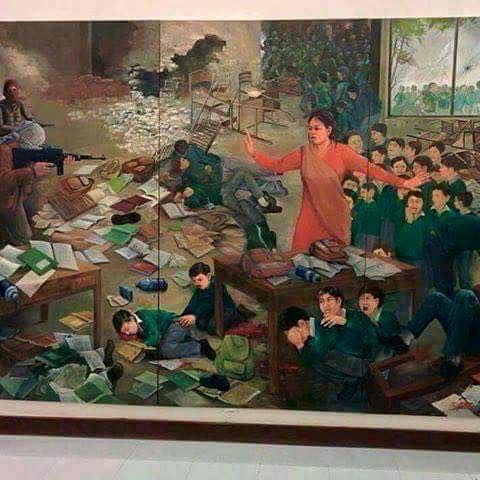
He said many tried to hide under the desks but were shot anyway, adding that there were around 150 students in the hall at the time.
According to DG ISPR Lt General Asim Saleem Bajwa, the military recovered about 100 bodies from the auditorium.
The seven attackers, wearing explosive vests, all died in the eight-hour long encounter.
In the administration building, where the military spokesperson said the final gunbattle between security forces and militants had taken place, the walls were covered with bullet and shrapnel marks. Streaks of blood and soot marked where some of the attackers blew themselves up.
.jpg)
.jpg)
.jpg)
.jpg)
.jpg)
.jpg)
.jpg)
.jpg)
The wounded students — some still wearing their green school blazers — flooded into hospitals as terrified parents searched for their children.
.jpg)
.jpg)
.jpg)
By evening, funeral services were already being held for many of the victims as clerics announced the deaths over mosque loudspeakers.
.jpg)
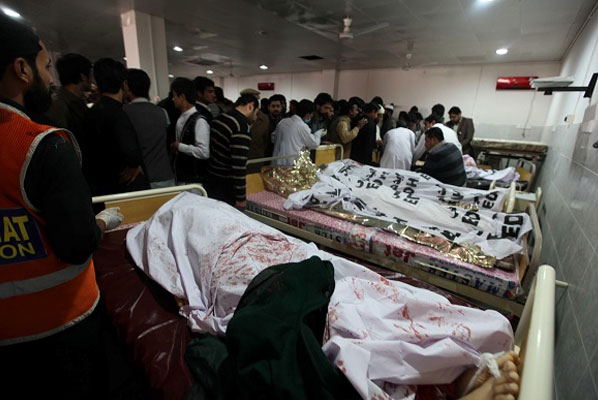
.jpg)
.jpg)
.jpg)
The federal government announced three days of mourning for what appeared to be Pakistan s deadliest encounter with banned outfit since a 2007 suicide bombing in the port city of Karachi that killed 150 people.
TALIBAN CLAIMED RESPONSIBILITY
In a statement to reporters, Taliban spokesman Mohammed Khurasani claimed responsibility for the attack, saying it was retribution for the military’s operation in nearby North Waziristan, the northwestern tribal region where the group’s fighters largely have been based.
SURVIVORS’ ACCOUNT
The next day after the attack, speaking from his bed in the trauma ward of the city’s Lady Reading Hospital, Shahrukh Khan, 16, said he and his classmates were in a careers guidance session in the school auditorium when four gunmen wearing paramilitary uniforms burst in.
"Someone screamed at us to get down and hide below the desks," he said.
"I saw a pair of big black boots coming towards me, this guy was probably hunting for students hiding beneath the benches."
Khan said he felt searing pain as he was shot in both his legs just below the knee.
He decided to play dead, adding: "I folded my tie and pushed it into my mouth so that I wouldn’t scream.
"The man with big boots kept on looking for students and pumping bullets into their bodies. I lay as still as I could and closed my eyes, waiting to get shot again.”
"My body was shivering. I saw death so close and I will never forget the black boots approaching me -- I felt as though it was death that was approaching me."
Another student, Hammad Ahmed, added: "I was with my friends in the corridor in front of my class when we heard gunshots."
"We rushed inside the classroom, our teacher closed the door, she was trying to lock it when the terrorists kicked on the door and forced it open," he continued.
"All 10 of my classmates and our teacher died, only I survived," he said.
But like Khan, he survived despite being shot in the feet because his attackers assumed he was already dead and moved on.
Survivor Ahmad Faraz, 14, described the carnage the best he could. "There were kids under the desks. One gunman spoke and the other replied: ‘Do not leave a single one alive‘," Faraz told AFP from hospital.
"And then they begin killing us one by one, under the desks and under the benches. I was watching them with one eye and one came closer to me, it was like a nightmare."
"He shot me in the shoulder and I thought ‘This is the end’. Then he turned to another desk. I heard the screaming with every bullet they fired."
Another gut-wrenching account of the massacre came from 13-year-old survivor Ehsan Elahi, an eighth grade student who was busy with his classmates getting first aid training from army instructors at the main hall of the school when he heard the sound of gunfire nearby.
.jpg)
PHOTO: 13-year-old survivor Ehsan Elahi.
He told: “Our teachers and instructors asked us to calm down but the sound of the bullets kept on closing on us. In the next minute, the glass of windows and doors of the hall smashed with bullets. Some people started kicking the hall doors.”
He said: “Everybody was trying to find a place to hide but there was no such places in the hall. The students were crying and hauling. There were only chairs and benches to hide behind and under. I jumped behind a bench and laid on the ground.” He said the attackers burst in and started spraying bullets like hell”.
More horrifying accounts emerged of a female teacher who was burnt alive as she courageously stood in the path of terrorists and told her students to run for their lives.
Afsha Ahmed, 24, confronted the marauding gunmen when they burst into her classroom and told them: “You can only kill my students over my dead body.”
The militants doused her with petrol and set her alight, but she still mustered the strength to beckon her pupils to flee.
One of her students, 15-year-old Irfan Ullah, wept as he recalled her incredible bravery. He said: “She was a hero, so brave. She jumped up and stood between us and them (terrorists) before they could target us.”
Irfanullah remembers her last words, she said: “I won’t see my students lying in blood on the floor”.
Irfan, who suffered serious injuries to his chest and stomach in the chaos, said he hoped Mrs Ahmed would forgive him for not trying to protect her and for any mistakes he ever made in class.
“I felt so selfish as we ran away to safe our lives instead of trying to save our teacher who sacrificed her life for our better tomorrow,” he added.
Tahira Qazi, the principal of the Army Public School and College in Peshawar, was set on fire by the militants. It is believed she was targeted because she is married to a retired army colonel, Kazi Zafrullah.
.jpg)
PHOTO: Martyred principal Tahira Qazi
Another student, Dawood Ibrahim was the only member of class 9 who lived after the tragic day. He didn’t go to school on the morning of the attack because his alarm didn‘t go off.
.jpg)
The trauma has lingered, says Andaleeb Aftab, a chemistry teacher at the school who fled into a bathroom with other staff after gunmen opened fire on them in a hallway.
Aftab‘s son, 16-year-old Huzaifa, was among those who died in the auditorium.
.jpg)
In their last exchange, she said, he came to the staff room and asked her for pocket money.
"But I told him I just saw you taking pocket money from your father in the parking lot -- so don‘t double cross me!" she told AFP.
Aftab was trapped in the bathroom until evening, listening for hours as the attackers blew themselves up one by one.
It was only after she was rescued that she learned her son had died.
"They made our college a graveyard," she says.
GLOBAL SUPPORT - QUOTES FROM AROUND THE WORLD
World leaders condemned the massacre of schoolchildren as "heinous" and "an act of horror" in an outpouring of global revulsion at the attack.
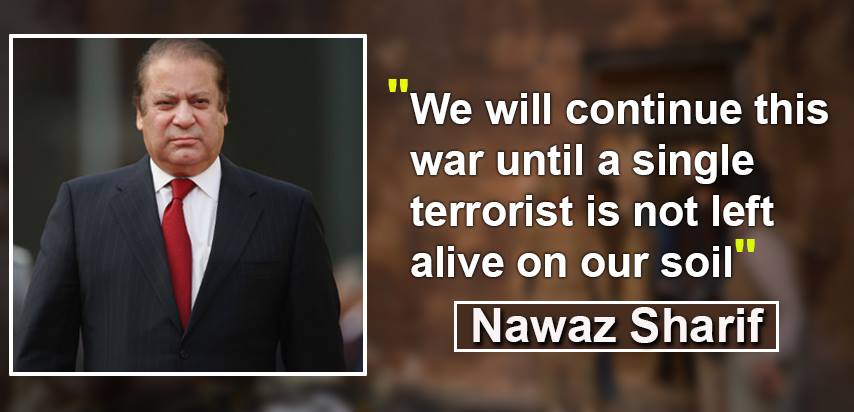
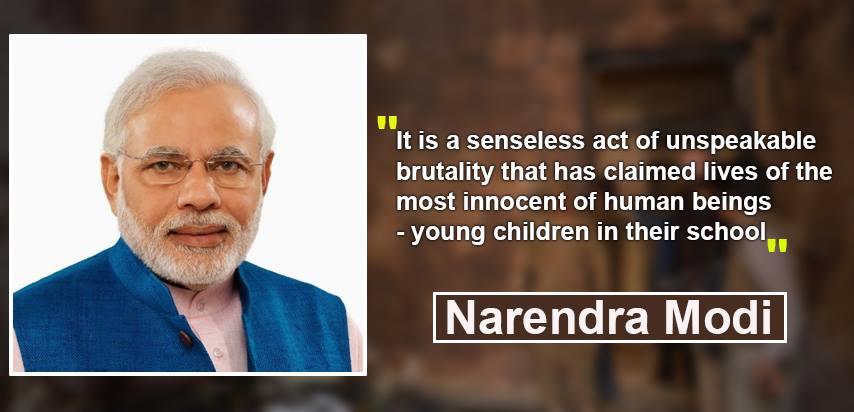
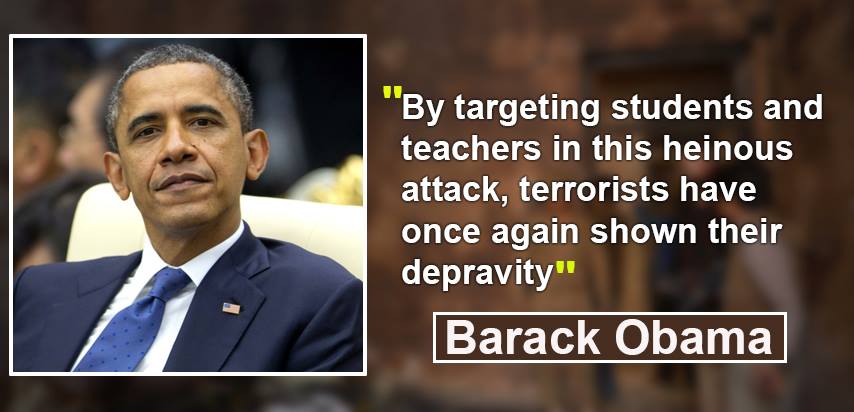
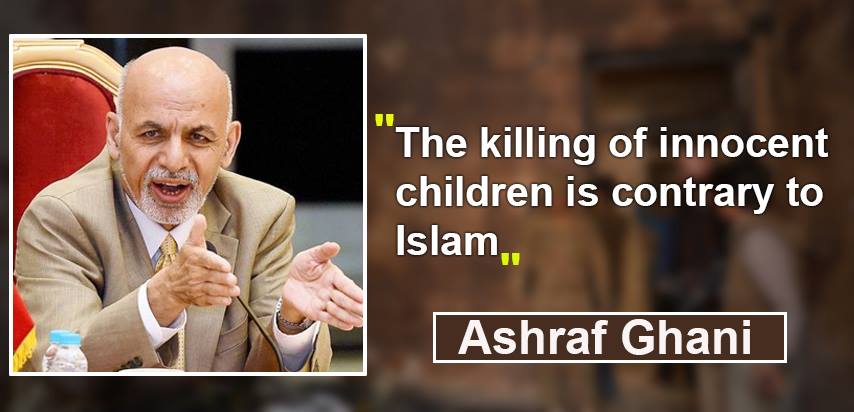

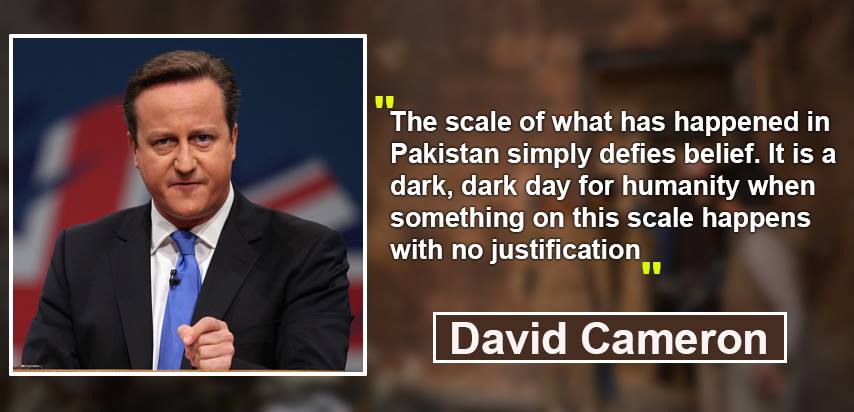
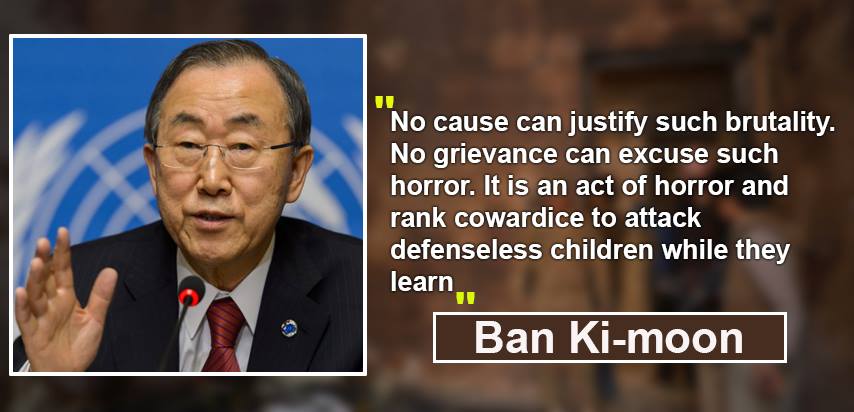
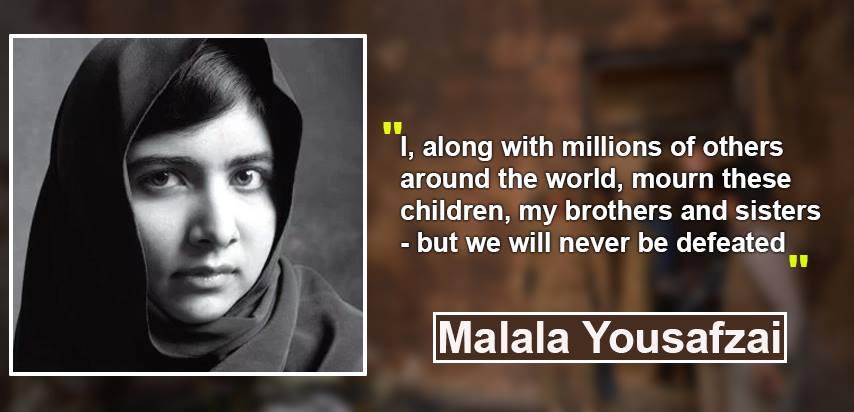
Pakistani cricketers also sent a message of condolence from the United Arab Emirates, where they were playing a one-day series against New Zealand.
.jpg)
Stunned people held candlelight vigils in solidarity with the Peshawar victims.
.jpg)
.jpg)
.jpg)
.jpg)
.jpg)
In some parts, people also offered funeral in absentia for the victims.
.jpg)
.jpg)
.jpg)
Students in various schools from around the world paid tribute to the victims of Peshawar school attack.
.jpg)
.jpg)
.jpg)
Disabled children also held banners in memory of students killed during an attack on the army school.
.jpg)
.jpg)
APS UNITES NATION AGAINST TERRORISM
The tragic incident hardened Pakistan‘s resolve in fight against terrorism and brought the nation together who demanded from the authorities to take strict action to avert such incidents in the future.
Since then, the government has stepped up military operations in the tribal areas, reinstated the death penalty and allowed military courts to try civilians — all attempts to crack down on terrorism.
More than 300 convicted prisoners have been executed since the death penalty was controversially reinstated. Hangings were initially reinstated only for those convicted of terrorism, but in March they were extended to all capital offences.
Recently, four terror convicts identified as Maulvi Abdus Salam, Hazrat Ali, Mujeeb ur Rehman, and Sabeel, were executed at a high security prison in Kohat for their involvement in the APS attack. They were sentenced to death by the military courts.
Four men executed had petitioned for clemency, but President Mamnoon Hussain rejected the requests. Army Chief General Raheel Sharif ordered the hangings a few days ago in a special military court created for terrorism cases.
“Pakistan has changed after the Peshawar tragedy. The merciless killings of our children convinced us that the perpetrators of such crimes do not deserve any mercy,” Prime Minister Nawaz Sharif said last month. “The death sentence awarded to the four terrorists, in fact, was the will of the entire nation.”
The Khyber Pakhtunkhwa government also gave permission to teachers to carry concealed firearms in response to the December 16 attack. Several teachers licensed and trained now carry firearms in schools.
.jpg)
.jpg)
(Jan. 27, 2015, a police commando gives weapons training to teachers in Peshawar Pakistan.)
Pak Army also intensified operation Zarb-e-Azb in the North Waziristan tribal region, killing more than three thousand terrorists since June 15, 2013. The army claims that most parts of the region are under control now.
ALSO READ: Terrorists backbone broken, 3400 terrorists killed in operation Zarb-e-Azb: ISPR
The effort has seen levels of militancy-linked violence fall to their lowest levels since 2007, the year the Pakistani Taliban came into being.
APS STUDENTS - A SYMBOL OF RESILIENCE
In a poignant symbol of perseverance despite the horrors they had endured, children returned to the Army Public School on January 12, 2015.
.jpg)
A ceremony was held at the school to mark its reopening, and classes were held a day later.
.jpg)
After the attack, schools around Pakistan have raised their boundary walls, added armed guards and installed metal detectors among numerous steps to secure the future of Pakistan.
ARMY’S TRIBUTE TO APS MARTYRS
In a beautiful new song just released by the Inter-Services Public Relations (ISPR), school children call for avenging one of the deadliest attacks on country’s future by teaching the children of the enemy.
The moving new song emphasizes on the power of the pen and how it is mightier than sword.
WATCH VIDEO BELOW:


